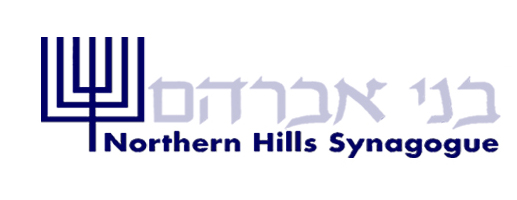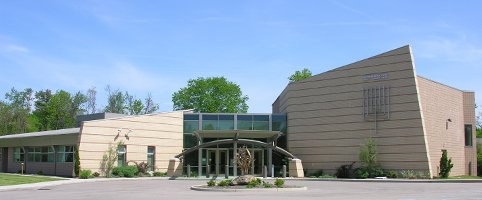50 Years of Northern Hills Synagogue
First Night of Rosh Hashanah, 5770 /2009
Fifty years ago, in 1959, Fidel Castro became the leader of Cuba, Alaska and Hawaii became the 49th and 50th states of the United States, and Pope John XXIII convened the Second Vatican Council. The Marx Brothers made their last television appearance together, the Los Angeles Dodgers won the World Series, and the Cincinnati Reds tied for 5th place in the National League. Congregation New Hope dedicated its synagogue building on Crest Hill Avenue in Roselawn, and, on March 25, 1959, the Yoo-Hoo-Dim, Northern Hills Jewish Couples Club, held its first meeting at the home of Arnold Held, 770 Converse Drive, in Forest Park.
During the coming year, we shall celebrate the 50th anniversary of our wonderful congregation. The biggest event of the year will be a gala dinner and celebration on Saturday night, Jan. 23, 2010, but that will be only one of many happenings, large and small.
Tonight, as we begin the year 5770 of the world, according to the traditional chronology, and as we pass through the 50th year of NHS-CBA, I would like to share with you a few thoughts about what is important about our congregation. Of course, the list is subjective; what is important to me may not be important to others. However, I strongly suspect that my thoughts on the subjects are not too different from many of yours. Also, the subject is complex. Things which are positive in some ways may be negative in others. However, this is not an occasion for subtle analysis.
Now, I don’t think that I am capable for speaking for 15 minutes or so without qualifying my words in some ways (in fact, I am doing it right now), but, for the most part, I shall be presenting a simplified view of what is important about our congregation. With respect to each point that I shall make, I shall suggest an associated task to which we should apply ourselves this year.
The first thing that comes to my mind is Conservative Judaism. Northern Hills Synagogue was not founded as a Conservative congregation. For a while, it tried hard to avoid any denominational label. Norm Weiser, a”h, one of the founding members of the congregation, who was one of my main informants on the early years of the congregation, told me once that he, very traditional in some ways, would come to services with his head uncovered in order to show how open the congregation was.
This approach didn’t work, and the congregation brought in a synagogue consultant (a so-called “shul doctor”), who advised the congregation that it had to articulate a religious orientation through a denominational affiliation. In 1963, Northern Hills Synagogue joined the United Synagogue of America (now the United Synagogue of Conservative Judaism). Some members of the congregation, who didn’t want to be part of a Conservative synagogue, resigned, but most stayed.
Over the years, our congregation has increased its involvement in the Conservative movement. Our auxiliaries, the Sisterhood, Men’s Club, and Youth Groups, have (most of the time) been affiliated with the appropriate national movement organizations. I attended my first United Synagogue event in the spring of 1976, in Dayton. Jeff Bassin recently served as president of the Great Lakes and Rivers (GLR) Region of USCJ, and he still serves on the national board. Renee Roth has served on the national USCJ Commission on Jewish Education. We have also participated actively in program sharing within the Conservative movement, through submitting our best programs to the biennial Solomon Schechter Award competition, and we have won, over six cycles, 21 awards.
Rabbi Yitzhak Greenberg, one of the most creative thinkers in contemporary American Jewish life, once said that it doesn’t matter which denomination you are affiliated with, as long as you are ashamed of it. The saying sounds very clever, but I believe that Greenberg is wrong. To be sure, our basic identity should be, not “Conservative Jewish,” but “Jewish,” and we know that no denomination or organization has a monopoly on truth or on Judaism. Nevertheless, there are so many options and possibilities within Judaism that we do well to align ourselves with others whose approach is similar to ours.
To me, an affiliation with the Conservative movement means, as I have said many times, a commitment to the combination of traditional religious observance and modern study and thought. Conservative Judaism is based on the observance of kashrut, Shabbat and Holidays in a recognizably traditional form, and the traditional Hebrew order of prayers. For me, coming from the Reform movement, this basis is essential, because, while there are some people in the Reform movement who are more or less traditionally observant, they are on their own as far as the movement goes.
It is of huge significance to me to know that, at any Conservative institution or function, the food will be kosher. At the same time, our movement recognizes the legitimacy and importance of critical thought. To me, critical thinking is a religious activity, and I could not be part of a movement that did not recognize its place.
Rabbi David Wolpe of Los Angeles caused a stir in the Jewish world when he said, in a Passover sermon in 2001, that the Biblical account of the exodus is not historically accurate. When someone at the Jewish Theological Seminary, the central institution of Conservative Judaism, was asked if JTS endorsed that view, he replied that any seminary professor would have said the same thing. Read the essays at the back of our Humash Etz Hayim and you will see the richness and complexity of the Conservative approach to our tradition.
What I have said about the place of traditional religious observance in Conservative Judaism is an ideal. It applies, in reality, only to our institutions and organizations. I think that something like 15% of the members of NHS keep kosher homes, and a smaller number of people keep kosher across the board.
That reflection brings us to the second aspect of Conservative Judaism that is important, and that is its “big tent” character. The Conservative movement resisted formulating a set of principles for a long time, because it wanted, in the words of the 1913 constitution of the United Synagogue, to “embrace all [those] essentially loyal to traditional Judaism”. When it finally produced a statement of beliefs, Emet Ve-emunah, in 1988, it was a 57 page booklet full of “Some Conservative Jews believe this” and “Some Conservative Jews believe that”.
People laugh about this, but, in fact, our tolerance of different beliefs and of variations in personal observance is an expression of the important commitment to K’lal Yisrael, the entire Jewish people. The challenge that we have as a Conservative synagogue is to represent Conservative Judaism in a way that has enough punch to be meaningful and, at the same time, to accommodate a diverse constituency.
The second important feature that comes to my mind when I think of NHS-CBA is that we are unpretentious, not fancy. That quality has implications for how we deal with money, how we deal with kavod, and how we operate. We are a small budget, fiscally conservative, organization. When we were planning our relocation to the NE, someone who objected to the move said, “The synagogue will have to double its membership in order to pay for the new building..”
In fact, while we did project an increase in membership, it was much more modest. Someone once told me that she was going to resign from the synagogue because she could not afford to pay the stated dues. I told her that, if she wanted to be a member of the synagogue, then we wanted to have her, and she could get a dues reduction. She replied, “I don’t want to have to go before a committee with my tax return.” I told her, to her surprise, that she would not have to do any such thing.
One of you, at a recent synagogue committee meeting, said how impressed he was that people do not flaunt their titles, that he knew David Zucker for a long time before he learned that he is Dr. David Zucker. Similarly, at a recent discussion of the impact of the current economy on our synagogues, one of my colleagues said that our ability to save money on maintenance is limited by the fact that our members are mostly professionals who don’t like to get their hands dirty. In fact, we have doctors and professors dealing with plumbing and electricity, and the recent repair of our ark doors was carried out by three people with doctorates of one kind or another.
One of the historical stories about the congregation is how, when we were on Fleming Road., and before the Roth Sanctuary was completed in 1988, the same room served as the sanctuary and, under the name Litz Auditorium, as a social hall. If there was a luncheon or similar function after services, most people would go into the lobby, while a group of us would bring out tables and re-arrange chairs. I am glad that we don’t have to do that any more, but the same spirit is still alive in the congregation.
Our challenge with regard to this quality is how to continue as an active, stable, institution in a new social and economic situation. The annual synagogue budget, which was about $10,000 in 1965 and $54,000 in 1975, is now about $400,000; the money has to come from somewhere. We know well that the culture of volunteerism in America is not, for various reasons, what it was 50 years ago.
The third important characteristic of this congregation is our aspiration to be a true community. In his book Finding a Spiritual Home, to which I have referred on various occasions, Rabbi Sidney Schwarz presents the Synagogue as Community as a new paradigm for American synagogues. That has been our paradigm for decades. To a great extent, we are a synagogue of "out-of-town" people. Of the ten current synagogue officers, only three are originally from Cincinnati.
From the beginning, people have looked upon the congregation as their extended family. What developed organically has now been institutionalized, and our Gemilut Hasadim program, which deals with Shabbat and holiday hospitality and assistance in times of personal difficulty, won a gold Solomon Schechter Award from the United Synagogue in 2002. Our challenge in this area is to do better. From time to time, we are shocked to hear that someone in the congregation feels snubbed or neglected. Nobody bats 1000, and we should not beat ourselves up because we are not perfect. On the other hand, we should not let the acknowledgement “Nobody’s perfect” lead us to be complacent and self-satisfied.
During this new year, the 50th year of NHS, I hope that we shall revel in the celebration of our wonderful congregation and our community, and I hope that we shall reflect on the meaning of those things which we celebrate, to reinforce those values, Conservative Judaism, lack of pretense, a sense of community, and others, which make Northern Hills Synagogue – Cong. B’nai Avraham what it is.

